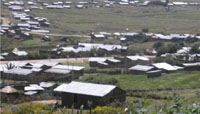
The incidence of malaria is generally lower in urban areas than in rural areas. There are a number of reasons for this:
However, rapid urbanisation of areas within or on the outskirts of urban centres is commonly done in an uncontrolled fashion without thought or planning (figure below). The settlers are mainly migrant workers from rural villages. Conditions are crowded; housing is often of poor quality or is of temporary construction; and the provision of health care and sanitation is often inadequate.

Settlers tend to dig several pits to extract stone and soil for house construction, creating numerous breeding grounds for mosquitoes. This can lead to explosive growth of mosquito vectors, increased exposure of the population to vectors due to poor housing, and amplification of disease to epidemic proportions through lack of effective treatment.
Your main responsibility as a rural health professional is mainly to provide care and set up preventive measures in rural communities. However, some semi-urban settlements at the periphery of urban centres could fall under the rural classification and be part of your catchment area. Remember that people living in such semi-urban centres can be at a higher risk of malaria than typical rural communities.